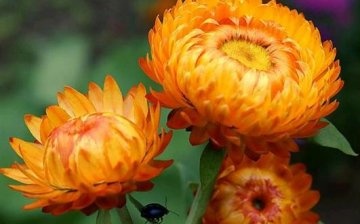Gelikhrizum on the photo - "golden sun"
Gelikhrizum in the photo, tsmin, immortelle - these are the names of one kind of plants, which flower growers usually call immortelle. The name of the flowers was given to the bright golden colors of the inflorescences, similar to small suns (Helios is the God of the sun, chryso is gold).
Of the variety of immortelles, helichrisum in the photo (cmin bracts) is better known. It is the scientific botanical name for a perennial plant grown as an annual plant. For brightly colored red, pink, yellow, orange, white inflorescences (or rather, rigid scales of the inflorescence wrapper), which do not lose color and do not fade even after cutting, the people call the flower an immortelle. The ability to maintain the juiciness of color for a long time is widely used for drawing up winter bouquets and makes the immortelle the most popular in the group of dried flowers.
These flowers are no less beautiful in the garden. Despite the fact that helihrizums bloom from June to September, blooming immortelles can be had much earlier - in pots or window boxes. You just need to keep the gelichrizum in a cool, bright place from the fall, and in February to cut it.
Gelichrizum is photophilous, grows well in sunny places, some even tolerate the sun. Bracts immortelle is mainly propagated by seeds, while other species are vegetatively propagated. Sow in open ground after warming up the soil or in boxes (end of March-April). High-quality feeding will only benefit. Flowering begins in June, and after 35-40 days a fluff forms on the baskets - these are the seeds that are ripe. If not collected, they will be washed away by the rain. Seeds remain viable for 3 years.




Once upon a time I was very lucky with the acquisition of immortelle seeds, there was a mixture of multi-colored gelichrizum. All the seeds sprouted and in the summer began to delight with unusually varied shades of flowers.